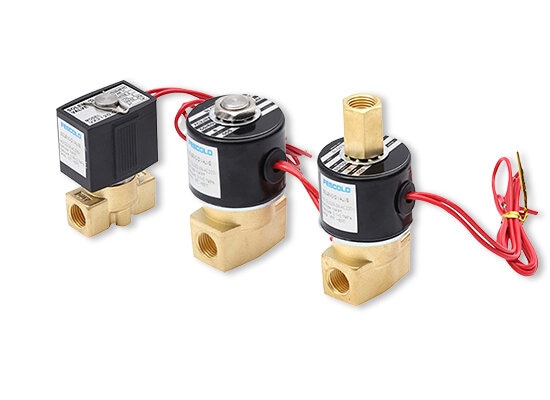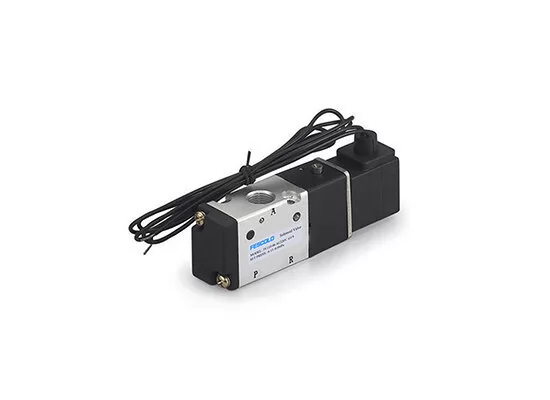Introduce
As modern industries increasingly rely on remote and programmable operations, A solenoid valve is an electric output device that converts electrical energy into a linear mechanical force. It enables precise control over parameters such as the on/off state, direction, flow rate, and speed of liquids or gases through electromagnetic action, significantly enhancing the automation level, response speed, and operational efficiency of industrial systems.
What is a Solenoid Valve?
The solenoid valve is an automatic control component that controls the airflow direction in actuator through an electromagnetic coil. Its structure mainly includes the coil, valve spool, spring, valve body, and other parts. During operation, the coil is energized to generate magnetic force, which drives the valve spool to switch the air passages, enabling the flow or cut-off of air, thereby controlling the action of actuators.
This electric solenoid valve features fast response, compact structure, and precise control. It is widely used in automated production lines, packaging machinery, automotive manufacturing, food processing, electronic assembly, and other industrial fields, serving as a core control component in modern pneumatic systems.
Advantages of solenoid valve
Quick response: Solenoid valves can be activated upon power on, with millisecond level response, suitable for frequent operation.
Simple structure and easy maintenance: modular design makes air solenoid valve easy to disassemble and replace components.
Low power consumption: The control part of electric valve only requires short-term current drive, which is energy-saving and environmentally friendly.
Good compatibility and remote control:Solenoid valve can seamlessly integrate with PLC, DCS and other systems to achieve programmatic operations.
High cleanliness and long lifespan:Pneumatic solenoid valve controls stable compressed air medium, which has stronger cleanliness and service life.
Strong material compatibility:2way solenoid valve can customize valve body and sealing material according to the composition of the mixed medium
The function of solenoid valve
Switching the direction of the air path: controlling the airflow to different channels, achieving actions such as cylinder expansion and contraction, gripper opening and closing.
Keep the gas path sealed:Prevent gas leakage and ensure stable system pressure.
Realize complex control capabilities:Pneumatic solenoid valves feature multi-position and multi-port configurations such as 3/2, 4/2, 5/2, and 5/3, offering more powerful control capabilities compared to solenoid valves used for mixed media.
Realize multi-channel control:By combining multiple channels, complex pneumatic action sequences can be achieved.
Active control:Pneumatic Solenoid Valve controls the movement of the pneumatic actuator by actively switching the flow direction of compressed air in response to electrical signals.
Application of solenoid valve
Automatic filling equipment:2/2Pneumatic Solenoid Valve can control the start stop control of the gas source.
Industrial automation equipment:5/2Penamtic Solenoid Valve can be used to control the execution structure of high-speed reciprocating motion.
CNC equipment and robotic arms:Added a 5/3 pneumatic Solenoid Valve to control devices that require pause, buffering, and precise positioning in intermediate states.
Medical and laboratory equipment:2 way solenoid valve can control various media channels such as pure water, oxygen, medicine, gas, etc., quickly cut off, and have good sealing performance.
Industrial automation equipment:3-Way soleoid valve switches gas/liquid flow paths between three-way positions to achieve fluid medium diversion or reversal.
Types of Solenoid Valves
A solenoid valve is an electric output device that converts electrical energy into a linear mechanical force. There some solenoid valve types as follows:
Way:The number of internal flow passages in a solenoid valve, determining how many paths the airflow can pass through.
The 2-way solenoid valve has a simple structure with two ports and two positions, primarily used for on/off control of A mixture of gases, liquids, and vapors. It features fast response and compact size, making it suitable for frequent switching applications. Common types include normally closed and normally open, In addition, there are also 3-way and 5-way valves, which are widely used in fluid systems across Low pressure to high pressure ranges and high temperature environment.
Position:It indicates the number of different positions the valve spool can switch to. Each position corresponds to a different airflow connection state, enabling various control functions and status.
Simply put, a 2-position valve has only two states: open and closed. A 3-position valve adds a middle position state. The more positions a valve has, the more airflow states it can achieve, allowing it to meet more diverse operating requirements.
Both pneumatic solenoid valves and mixed medium solenoid valves have different ways and positions, and can achieve complex fluid control capabilities. The difference between the two is that the structure of mixed medium solenoid valves is simpler, while the working principle of pneumatic solenoid valves is more complex.
How Does a Solenoid Valve Work
Working principle of 2-Way solenoid valve:
The 2-way solenoid valve used for controlling mixed media has a simple structure and directly controls the on-off of the medium. Inside, there is a solenoid coil that generates a magnetic field when energized, driving the plunger to move up and down, thereby opening or closing the fluid passage between the two ports.
Working principle of pneumatic solenoid valve:
A pneumatic solenoid valve is controlled through a combination of electrical and pneumatic signals, using a pilot-operated mechanism. It is designed for applications involving large flow rates, high pressure, and complex multi-position switching. For detailed information on the control process, please refer to our technical blog.
Solenoid valve parameters
The following technical parameters are based on the example of pneumatic solenoid valve. Understanding more about the attribute parameters of solenoid valves can help to apply them more reasonably.
Parameter
| Solenoid valve |
| Control Type | Single Solenoid / Double Solenoid |
| Port Size | G1/8", G1/4", G3/8", G1/2" |
| Operating Pressure | 0.15 – 0.8 MPa (1.5 – 8 bar) |
| Pilot Pressure | ≥ 0.15 MPa |
| Working Medium | Filtered compressed air |
| Ambient Temperature | -10°C to +50°C |
| Operating Temperature | 5°C to 60°C |
| Coil Voltage Options | DC24V, AC110V, AC220V |
For more detailed inquiries or specific air operated pneumatic solenoid valve or technology solutions, reach out to Fokca which is global Pneumatic valves supplier for expert advice and tailored recommendations,or you can contact us !
















